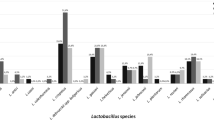Abstract
To explore the potential protective role of urogenital lactobacilli against urinary tract infection (UTI), lactobacillus cultures were performed on stool and urine specimens and periurethral/vaginal swabs of febrile infants who were suspected of having UTI. Those infants diagnosed with UTI based on the results of the suprapubic urine cultures were allocated to the UTI group (n = 60), and those who had a simple viral illness with negative urine cultures were allocated to the control group (n = 31). Lactobacilli were anaerobically cultured in lactobacillus-specific DifcoTM Rogosa SL agar for 48 h at 37°C and then counted. The lactobacillus colony counts for the stool and urine specimens and periurethral swabs from the UTI group were significantly lower than those for the control group (P < 0.05). The geometric means of stool, periurethra, and urine lactobacilli in the UTI group were significantly lower than those in the control group (P < 0.05). The colony count of the vaginal lactobacillus demonstrated an equivocal difference between the UTI and control group. In conclusion, this is the first prospective case–control study to demonstrate reduced lactobacillus urogenital colonization in infants with UTI. Our results support the view that less urogenital lactobacillus colonization may be a risk factor for UTI in infants even though there is an unclear possibility that the UTI itself could be the cause of the lower lactobacillus colonies.

Similar content being viewed by others
References
Usein CR, Damian M, Tatu-Chitoiu D, Capusa C, Fagara R, Mircescu G (2003) Comparison of genomic profiles of Escherichia coli isolates from urinary tract infections. Roum Arch Microbiol Immunol 62:137–154
Stamey TA, Sexton CC (1975) The role of vaginal colonization with Enterobacteriaceae in recurrent urinary tract infections. J Urol 113:214–217
Newman D (1915) The treatment of cystitis by intravesical injection of lactic bacillus cultures. Lancet 14:330–332
Bruce AW, Chadwick P, Hassan A, van Cott GF (1973) Recurrent urethritis in women. Can Med Assoc J 108:973–976
Gupta K, Stapleton AE, Hooton TM, Roberts PL, Fennell CL, Stamm WE (1998) Inverse association of H2O2-producing lactobacilli and vaginal Escherichia coli colonization in woman with recurrent urinary tract infections. J Infect Dis 178:446–450
Herthelius M, Gorbach SL, Mollby R, Nord CE, Pettersson L, Winberg J (1989) Elimination of vaginal colonization with Escherichia coli by administration of indigenous flora. Infect Immun 57:2447–2251
Marie TJ, Swantee CA, Hartlen M (1980) Aerobic and anaerobic uretheral flora of healthy females in various physiologic age groups and of females with urinary tract infections. J Clin Microbiol 11:654–659
Reid G, Chan RC, Bruce AW, Costerton JW (1985) Prevention of urinary tract infection in rats with indigenous Lactobacillus casei strain. Infect Immun 49:320–324
Asahara T, Nomoto K, Watanuki M, Yokokura T (2001) Antimicrobial activity of intraurethrally administered probiotic Lactobacillus casei in a murine model of Escherichia coli urinary tract infection. Antimicrob Agents Chemother 45:1751–1760
Fraga M, Scavone P, Zunino P (2005) Preventive and therapeutic administration of an indigenous lactobacillus sp. strain against Proteus mirabilis ascending urinary tract infection in a mouse model. Antonie van Leeuwenhoek 88:25–34
Martin R, Langa S, Reviriego C, Jiminez E, Marin ML, Xaus J, Fernández L, Rodríguez JM (2003) Human milk is a source of lactic acid bacteria for the infant gut. J Pediatr 143:754–758
Marild S, Hansson S, Jodal U, Oden A, Svedberg K (2004) Protective effect of breastfeeding against urinary tract infection. Acta Pediatr 93:164–168
Bruce AW, Reid G (1988) Intravaginal instillation of lactobacilli for prevention of recurrent urinary tract infection. Can J Microbiol 34:339–343
Reid G, Bruce AW, Taylor M (1995) Instillation of Lactobacillus and stimulation of indigenous organisms to prevent recurrence of urinary tract infection. Microecol Ther 23:32–45
Reid G, Bruce AW, Taylor M (1992) Influence of three-day antimicrobial therapy and lactobacillus vaginal suppositories on recurrence of urinary tract infection. Clin Ther 14:11–16
Gerasimov SV (2004) Probiotic prophylaxis in pediatric recurrent urinary tract infection. Clin Pediatr 43:95–98
Lee SJ, Shim YH, Cho SJ, Lee JW (2007) Probiotics prophylaxis in children with persistent primary vesicoureteral reflux. Pediatr Nephrol 22:1315–1320
Chan RC, Bruce AW, Reid G (1984) Adherence of cervical, vaginal and distal urethral normal microbial flora to human uroepithelial cells and the inhibition of adherence of gram-negative uropathogens by competitive exclusion. J Urol 131:596–601
Velraeds MC, van der Mei HC, Reid G, Busscher HJ (1996) Inhibition of initial adhesion of uropathogenic Enterococcus faecalis by biosurfactant from lactobacillus isolates. Appl Environ Microbiol 62:1958–1963
Osset J, Bartolome RM, Garcia E, Andreu A (2001) Assessment of the capacity of lactobacillus to inhibit the growth of uropathogens and block their adhesion to vagina epithelial cells. J Infect Dis 183:485–491
Gill HS, Rutherfurd KJ, Prasad J, Gopal PK (2000) Enhancement of natural and acquired immunity by Lactobacillus rhamnosus (HN001), Lactobacillus acidophilus (HN017) and Bifidobacterium lactis (HN019). Br J Nutr 83:167–176
Matsuzaki T, Chin J (2000) Modulating immune responses with probiotic bacteria. Immunol Cell Biol 78:67–73
Dani C, Biadaioli R, Bertini G, Martelli E, Rubaltelli FF (2002) Probiotics feeding in prevention of urinary tract infection, bacterial sepsis and necrotizing enterocolitis in preterm infants. A prospective double-blind study. Biol Neonate 82:103–108
Reid G, Bruce AW, Fraser N, Heinemann C, Owen J, Henning B (2001) Oral probiotics can resolve urogenital infection. FEMS Immunol Microbiol 30:49–52
Reid G, Bruce AW (2006) Probiotics to prevent urinary tract infections: the rationale and evidence. World J Urol 24:28–32
Food and Agriculture Organization (FAO) (2001) Evaluation of health and nutritional properties of probiotics in food including powder milk and live lactic acid bacteria. Food and Agriculture Organization of the United States and World Health Organization Expert Consultation Report. Available at https://doi.org/www.fao.org/es/ESN/Probio/probio.html2001. Cordoban, Argentina
Reid G, Bruce AW (2001) Selection of lactobacillus strains for urogenital probiotic applications. J Infect Dis 183:S77–S80
Author information
Authors and Affiliations
Corresponding author
Rights and permissions
About this article
Cite this article
Lee, J.W., Shim, Y.H. & Lee, S.J. Lactobacillus colonization status in infants with urinary tract infection. Pediatr Nephrol 24, 135–139 (2009). https://doi.org/10.1007/s00467-008-0974-z
Received:
Revised:
Accepted:
Published:
Issue Date:
DOI: https://doi.org/10.1007/s00467-008-0974-z



